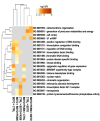Calcineurin inhibition prevents synaptic plasticity deficit induced by brain-derived tau oligomers
- PMID: 39239152
- PMCID: PMC11375858
- DOI: 10.1093/braincomms/fcae277
Calcineurin inhibition prevents synaptic plasticity deficit induced by brain-derived tau oligomers
Abstract
Compelling evidence suggests that cognitive decline in Alzheimer's disease is associated with the accumulation and aggregation of tau protein, with the most toxic aggregates being in the form of oligomers. This underscores the necessity for direct isolation and analysis of brain-derived tau oligomers from patients with Alzheimer's disease, potentially offering novel perspectives into tau toxicity. Alzheimer's brain-derived tau oligomers are potent inhibitors of synaptic plasticity; however, the involved mechanism is still not fully understood. We previously reported a significantly reduced incidence of Alzheimer's disease in ageing humans chronically treated with a Food and Drug Administration-approved calcineurin inhibitor, FK506 (tacrolimus), used as an immunosuppressant after solid organ transplant. Using a combination of electrophysiological and RNA-sequencing techniques, we provide here evidence that FK506 has the potential to block the acute toxic effect of brain-derived tau oligomers on synaptic plasticity, as well as to restore the levels of some key synaptic mRNAs. These results further support FK506 as a promising novel therapeutic strategy for the treatment of Alzheimer's disease.
Keywords: Alzheimer’s disease; FK506; LTP; tacrolimus; tau.
© The Author(s) 2024. Published by Oxford University Press on behalf of the Guarantors of Brain.
Conflict of interest statement
All the authors report no competing interests.
Figures




References
-
- Alzheimer’s Disease Facts and Figures . Alzheimer’s Disease and Dementia. Accessed 22 August 2023. https://www.alz.org/alzheimers-dementia/facts-figures
-
- Goedert M, Spillantini MG, Crowther RA. Tau proteins and neurofibrillary degeneration. Brain Pathol. 1991;1(4):279–286. - PubMed
Grants and funding
LinkOut - more resources
Full Text Sources
